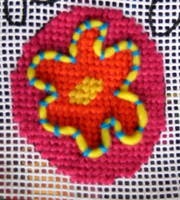
Updated September 20, 2019.
Lately I have been thinking about couching. It’s not a technique I do very often, and I think I’m not alone in this. A recent canvas I bought, one of Zecca’s coloring book canvases, has gotten me thinking about it. I’m planning on adding more couchiong to my projects. This article has great ideas for getting started.
This guest post from 2013 is by Brenda Stimpson of www.Needlepoint-For-Fun.com – your needlepoint home on the web.
Thanks to Brenda for letting me post this article from her recent newsletter.
In our house, ‘couching’ has two definitions. The first is what I like to do with a cup of tea on a Sunday afternoon (or a glass of wine, depending on how far past noon it is). The second definition, and probably the one you are all tuning in for, is the term used for laying down and securing a thread on canvas.
I have always called couching – well, couching (hence definition 1 above)! But, apparently, the correct pronunciation is KOO-ching (like KA-ching but without the benefit of pennies falling from the sky). However, now that I have dutifully informed you of this I want you to know that I will be continuing to call couching, couching.
I wanted to run a feature article on couching because it is such a useful technique, and so easy that sometimes I wonder why I don’t couch more often (definition 2).
Uses For Couching:
- Creating curved lines
- Adding definition and texture to an object on the canvas
- Using unusual fibers – ones that might not thread through the canvas well, but can sit on top of it
General Guidelines and How To Couch:

As an illustration I am going to couch the outline of this flower from an unprinted Casa canvas. By laying down a thick piece of wool to outline the flower I add definition to the design and give it a more contemporary look.

Here I am laying down yellow fiber on an orange background and I used a different color to secure the thread. You can use a contrasting thread, or one that matches.

I started and finished by bringing the couched thread from the back of the canvas. However, if you are couching a thread that will not go through a needle, or through the canvas, you can start and finish the ends on the front of the canvas as long as you secure them with stitches at the ends.
Usually the thread you are laying down is thicker than the thread you use to secure the laid thread. You can see from this picture that I am using cotton over wool.
Any thread can be used for couching because it sits on top of the canvas. So, let your imagination run wild. Stitching wool on a sheep? Why not couch in circles of raw spun wool? Stitching a basket? Why not couch some raffia onto the canvas. Imagine the different fibers you can use to give your canvas an organic look – fishing line, metallic thread. Almost anything can be couched onto needlepoint canvas.
The securing stitches should be spaced an appropriate distance apart to ensure the underlying fiber is held securely in place. Usually this is about ¼ to ½ inch apart, but it also depends on the dimension of the area you are couching and the thickness of the thread. For example if you are couching fine embroidery using a few strands of embroidery cotton, the securing stitches probably need to be closer together than this. So, use your judgment but try to keep the spacing even (except if you are turning tight curves or corners where you will probably need to place the securing stitches closer together in order to hold the couched thread to the canvas).
Pay attention to tension. You are not trussing a chicken; you are simply lightly securing the couched thread to the canvas. So, do not pull too tightly with your tie down stitch.
Use your imagination and have fun with couching!
About Janet M Perry
Janet Perry is the Internet's leading authority on needlepoint. She designs, teaches and writes, getting raves from her fans for her innovative techniques, extensive knowledge and generous teaching style. A leading writer of stitch guides, she blogs here and lives on an island in the northeast corner of the SF Bay with her family

Leave a Reply